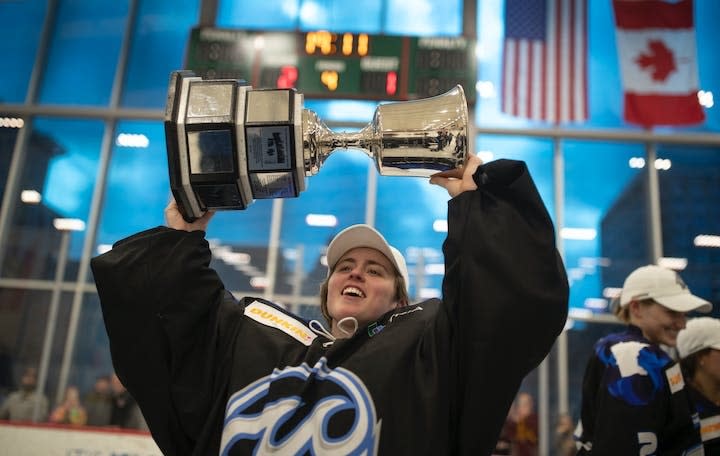Things to know as Minnesota joins new Professional Women’s Hockey League

When the organizers of the Professional Women's Hockey League thought about where to place their first six teams, geography played a part. Most of their top choices were concentrated in the eastern U.S. and Canada, but they ultimately decided one Midwestern outpost was too important to leave out.
"Minnesota is the state of hockey,'' league executive Jayna Hefford said. "It was always a priority market for us.''
The new league made it official Tuesday, announcing the Twin Cities would join Toronto, Montreal, Ottawa, Boston and the New York City area as its original six members when play begins in January. The PWHL still has many details to finalize, including team names, home rinks and schedules. But the basics — and more importantly, the money — are in place to launch the most viable, polished pro league in the history of the women's game.
The PWHL held a virtual news conference Tuesday to answer questions about what the league will look like and how it will operate. Here's what Hefford, its senior vice president of hockey operations, and board member Stan Kasten had to say.
When and where will the puck drop?
A 24-game regular-season schedule will start around Jan. 1, running through late May or early June. A full schedule is expected to be released in October. In future years, Kasten said, there will be a 32-game regular season from November to May, followed by at least two rounds of playoffs.
The "where'' is trickier. The PWHL is still finalizing training and game sites; some games will be in NHL arenas, and some will be in smaller venues, such as those that host minor-league men's teams.
In year one, all 12 of a team's home games might not be played in the same building, or even in its home city. Kasten said the league will collaborate with the NHL to hold several neutral-site games, including in cities not among the original six.
Who will play in the league?
Expect the 23-player rosters to be a mix of top talent from around the world. Team general managers — who are expected to be announced later this week — will be given a list of 300 eligible players as a starting point.
Each team can sign up to three free agents during a 10-day period that starts Friday, followed by a player draft Sept. 18 in Toronto. The draft will supply 15 more players per team. Non-drafted players can try out or negotiate contracts with any team. Rosters must include at least 28 players for training camps that begin Nov. 13.
The PWHL Players' Association already has negotiated a collective bargaining agreement that runs through 2031. The deal includes an average annual salary of $55,000, plus bonuses, a retirement plan and other perks. Longtime NHL executive Brian Burke, a former Edina resident, was announced Tuesday as executive director of the players' union.
Who is bankrolling the league, and how much money is committed to it?
Kasten clarified that two people — Mark and Kimbra Walter — are the sole financial backers of the PWHL. Mark Walter is controlling owner of the Los Angeles Dodgers and the WNBA's Los Angeles Sparks; he also is part-owner of the Los Angeles Lakers and the English Premier League's Chelsea Football Club.
A native of Cedar Rapids, Iowa, Mark Walter is CEO of Guggenheim Partners, a global financial services company with a reported $325 billion in assets under management.
While Kasten would not reveal the PWHL's budget, he said the Walters know it will be expensive to launch a new league. He added they are in it for the long run, with a 10-year business plan that includes expansion.
"We're prepared [for the expense],'' Kasten said. "We think of all those amounts of money not as being expenses or losses. We think of them as investments in what we're building.''
What is the NHL's involvement?
Kasten described the NHL as having a "consultative'' role at this point. He said the league has provided advice and assistance; NHL officials also have discussed joint business ventures between the leagues, such as sponsorships or events.
Kasten views that support as a vital step forward in the evolution of women's pro hockey.
"That's one of the elements that has not been there,'' he said. "The fact that it's there now is one of the major reasons I'm so confident about our long-term success.''
How will the PWHL be different from previous women's pro leagues?
In addition to that relationship with the NHL, the league has a wealthy financial backer, board members with extensive pro sports experience and a collective bargaining agreement with its players already in place. That immediately puts it miles ahead of any of its predecessors.
Kasten and Hefford said the league will operate on par with other major league sports, committing "real money'' to marketing and promotions and giving players top-notch facilities, amenities and staff. "We have an ownership group that provides the capital, the resources, the experience to do this in a professional, first-class way,'' Hefford said. "All of it is going to be different.''
Why these six markets, including Minnesota?
It was originally speculated that Minnesota could be left out in the cold. The collective bargaining agreement requires that teams fly to cities more than 400 miles away, so clustering teams in the East would hold down travel costs.
Hefford and Kasten said that didn't matter. "This was about finding the right members,'' Kasten said. "We just thought we had to have [a Minnesota team]. Because if there's anything like a women's hockey hotbed in the U.S., it probably is Minnesota. We really couldn't leave them out of the original six.''
Hefford said extensive research went into choosing the teams' locations. Factors included the availability of professional-quality training facilities and arenas, as well as an existing hockey fan base that would support the women's game.

